| Dalkey Tidy Towns |
  |
| Dalkey Tidy Towns |
  |
|
Wildlife
Newsletter for the Township of Dalkey December 2010 - Michael Ryan |
FEEDING
BIRDS IN WINTER |
|
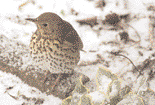 Thrush |
|
| Niger seeds, which are very fine and need a specific container to stop them spilling out, are great for attracting goldfinches and redpolls. Round balls of compressed fat and seed are fantastically valuable nutritionally, a choice food for robins and members of the tit family. Of course you can prepare your own fat or seedcakes for the birds and there’s lots of tips available online. The RSPB in the UK has a number of bird feeding recipes suggested by celebrity chefs. Rick Stein’s ‘suet and nut log’ sounds fine but I wouldn’t see myself in the kitchen preparing Antony Worrall-Thompson’s ‘crumble pastry maggots’. As I mentioned last month apples can be given to birds that wouldn’t normally come on to feeders like blackbirds or wintering thrushes. You can cut them up and leave them on the lawn or stick them on to twigs or branches. | 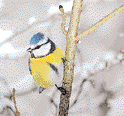 Blue Tit |
| I hang my feeders from the hook of wire clothes hangers and you can impale the apples on these as well. Blackbirds aren’t usually nimble enough to perch on feeders but they soon learn how to feed on apples. Don’t forget to clean the feeders regularly and clean away the fallen husks under the feeders. Photos: Courtesy Birdwatch Ireland |
| WOODSMAN,
DON’T SPARE THAT TREE ! Saturday 16th October found the woodlands on Killiney Hill resounding to the sound of loppers and saws cutting down saplings and trees in the undergrowth. Normally if anyone is cutting wood on the hill at the weekend it would be a cause of concern but in this case the intentions were good. The people wielding the tools were Conservation Volunteers and they we reengaged in cutting down and clearing out Sycamore trees. As anyone who has a garden will probably know sycamores are incredibly successful at spreading themselves and any bit of land left untended will often have a young sycamore breaking through the soil. They’ll even seed themselves in tarmac or any crack in a cement surface. They’re introduced, non-native and, although I do believe their flowers can be attractive to bees, they are generally of very little use to birds or any other creatures. Their ease of establishment and quick growth gives the man advantage over native trees and once they become established in woodlands they can out compete native plants and trees, shading the ground where otherwise native seeds could sprout and then become the dominant species. |
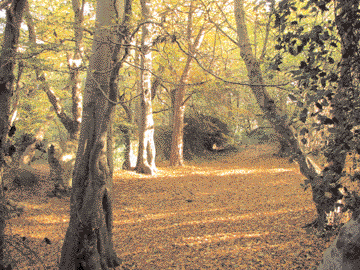 Dalkey Hill in Autumn Photo: M. Ryan |
| So it was good to see them being dealt with by a little group of well-intentioned people who had given up their Saturday morning to help the woods. Their good intentions were helped by a beautiful dry sunny morning and afterwards the light shone through where a dense mass of undergrowth had previously stood. Nearby there’s a good demonstration of how woodlands evolve. As one walks down the steps from the obelisk you come to the bottom of one set of steps where the remains of a large fallen branch from an oak tree are cut up and left by the path. Covered in moss the sections of wood are deliberately left by the parks rangers to slowly break down, feeding back into the soil and enriching it while many species of insects and fungi will feed on the dead wood. Just behind these logs in a very dense cluster of sycamores and elders are a little group of oak trees all strangely stunted at the top with jagged stumps and spindly branches. |
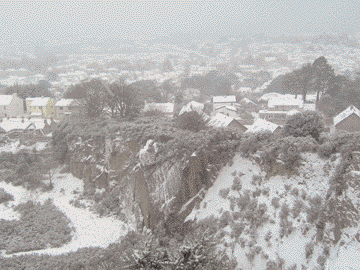 Winter Snow in Dalkey Quarry Photo: M. Ryan |
|
| The fires will sweep through, burning up the ferns and gorse but most of the vegetation will survive and be back within a few years. But the impact of many months of drought meant the fires that summer kept simmering long after the flames had gone. These fire burnt, sometimes for days down into the ground like a peat fire, destroying the top soil, sometimes even burning right down to the granite underneath. A particularly destructive fire on Killiney hill in mid August had swept down the hill destroying mature birch tree and burning off the gorse. The fire brigade had come and dealt with it but for days after you could still see the glowing embers under the blackened soil. You could see the fire was still simmering away and it was slowly but gradually moving down the hill towards that stand of oak trees.Concerned about the oak trees but hesitant to call out the very severely stretched fire brigade a relative helped me ferry containers of water from our house to the car, which we drove up to the car park. |  Red Squirrel in Oak Tree Photo: M. Ryan |
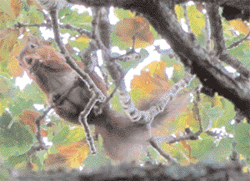 Red
Squirrel in Oak Tree Red
Squirrel in Oak TreePhoto: M. Ryan |
|